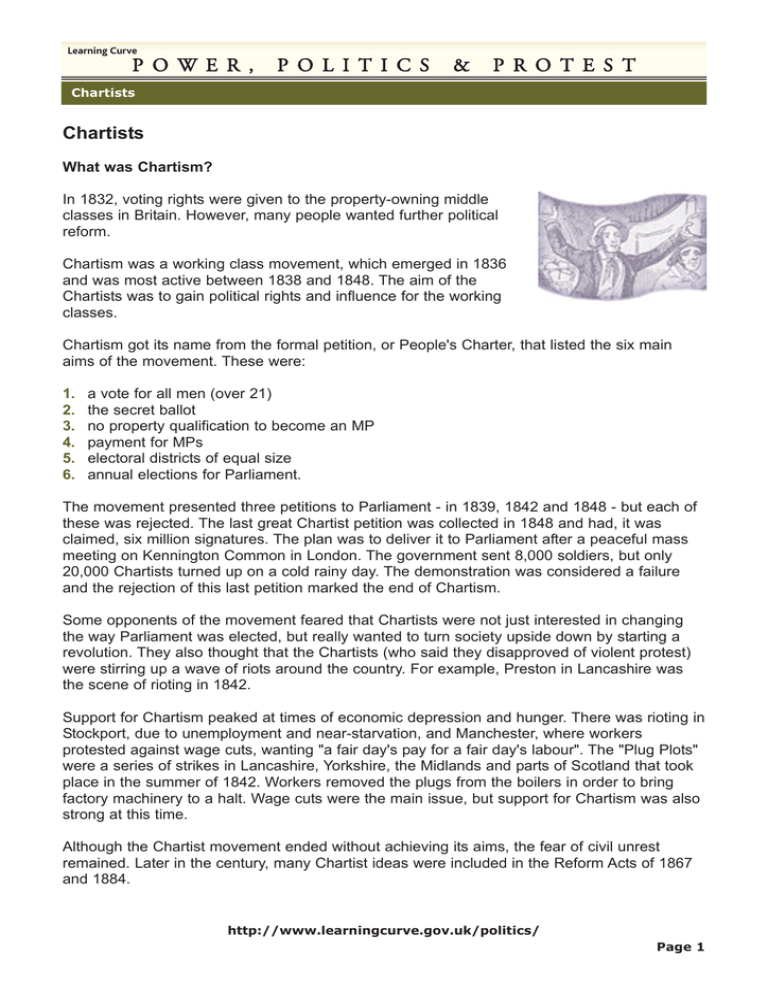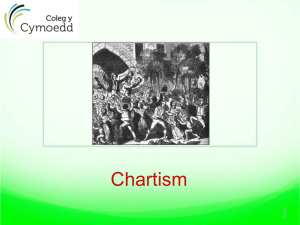m l t b o I == m l i... Chartists
advertisement

Learning Curve m l t b o I = m l i f q f ` p = C = m o l q b p q Chartists Chartists What was Chartism? In 1832, voting rights were given to the property-owning middle classes in Britain. However, many people wanted further political reform. Chartism was a working class movement, which emerged in 1836 and was most active between 1838 and 1848. The aim of the Chartists was to gain political rights and influence for the working classes. Chartism got its name from the formal petition, or People's Charter, that listed the six main aims of the movement. These were: 1. 2. 3. 4. 5. 6. a vote for all men (over 21) the secret ballot no property qualification to become an MP payment for MPs electoral districts of equal size annual elections for Parliament. The movement presented three petitions to Parliament - in 1839, 1842 and 1848 - but each of these was rejected. The last great Chartist petition was collected in 1848 and had, it was claimed, six million signatures. The plan was to deliver it to Parliament after a peaceful mass meeting on Kennington Common in London. The government sent 8,000 soldiers, but only 20,000 Chartists turned up on a cold rainy day. The demonstration was considered a failure and the rejection of this last petition marked the end of Chartism. Some opponents of the movement feared that Chartists were not just interested in changing the way Parliament was elected, but really wanted to turn society upside down by starting a revolution. They also thought that the Chartists (who said they disapproved of violent protest) were stirring up a wave of riots around the country. For example, Preston in Lancashire was the scene of rioting in 1842. Support for Chartism peaked at times of economic depression and hunger. There was rioting in Stockport, due to unemployment and near-starvation, and Manchester, where workers protested against wage cuts, wanting "a fair day's pay for a fair day's labour". The "Plug Plots" were a series of strikes in Lancashire, Yorkshire, the Midlands and parts of Scotland that took place in the summer of 1842. Workers removed the plugs from the boilers in order to bring factory machinery to a halt. Wage cuts were the main issue, but support for Chartism was also strong at this time. Although the Chartist movement ended without achieving its aims, the fear of civil unrest remained. Later in the century, many Chartist ideas were included in the Reform Acts of 1867 and 1884. http://www.learningcurve.gov.uk/politics/ Page 1 Learning Curve m l t b o I = m l i f q f ` p = C = m o l q b p q Chartists Find out more from these original sources: Home Office advice before the meeting, 1819 Engraving of events at St Peter's Fields, 1819 Letter on events at St Peter's Fields Letter on the conduct of the magistrates http://www.learningcurve.gov.uk/politics/ Page 2







